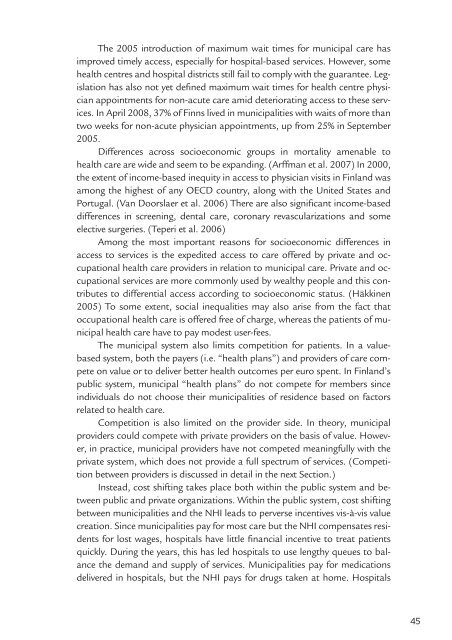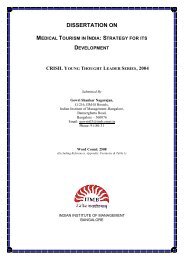The Finnish Health Care System - Institute for Strategy and ...
The Finnish Health Care System - Institute for Strategy and ...
The Finnish Health Care System - Institute for Strategy and ...
- No tags were found...
Create successful ePaper yourself
Turn your PDF publications into a flip-book with our unique Google optimized e-Paper software.
<strong>The</strong> 2005 introduction of maximum wait times <strong>for</strong> municipal care hasimproved timely access, especially <strong>for</strong> hospital-based services. However, somehealth centres <strong>and</strong> hospital districts still fail to comply with the guarantee. Legislationhas also not yet defined maximum wait times <strong>for</strong> health centre physicianappointments <strong>for</strong> non-acute care amid deteriorating access to these services.In April 2008, 37% of Finns lived in municipalities with waits of more thantwo weeks <strong>for</strong> non-acute physician appointments, up from 25% in September2005.Differences across socioeconomic groups in mortality amenable tohealth care are wide <strong>and</strong> seem to be exp<strong>and</strong>ing. (Arffman et al. 2007) In 2000,the extent of income-based inequity in access to physician visits in Finl<strong>and</strong> wasamong the highest of any OECD country, along with the United States <strong>and</strong>Portugal. (Van Doorslaer et al. 2006) <strong>The</strong>re are also significant income-baseddifferences in screening, dental care, coronary revascularizations <strong>and</strong> someelective surgeries. (Teperi et al. 2006)Among the most important reasons <strong>for</strong> socioeconomic differences inaccess to services is the expedited access to care offered by private <strong>and</strong> occupationalhealth care providers in relation to municipal care. Private <strong>and</strong> occupationalservices are more commonly used by wealthy people <strong>and</strong> this contributesto differential access according to socioeconomic status. (Häkkinen2005) To some extent, social inequalities may also arise from the fact thatoccupational health care is offered free of charge, whereas the patients of municipalhealth care have to pay modest user-fees.<strong>The</strong> municipal system also limits competition <strong>for</strong> patients. In a valuebasedsystem, both the payers (i.e. “health plans”) <strong>and</strong> providers of care competeon value or to deliver better health outcomes per euro spent. In Finl<strong>and</strong>’spublic system, municipal “health plans” do not compete <strong>for</strong> members sinceindividuals do not choose their municipalities of residence based on factorsrelated to health care.Competition is also limited on the provider side. In theory, municipalproviders could compete with private providers on the basis of value. However,in practice, municipal providers have not competed meaningfully with theprivate system, which does not provide a full spectrum of services. (Competitionbetween providers is discussed in detail in the next Section.)Instead, cost shifting takes place both within the public system <strong>and</strong> betweenpublic <strong>and</strong> private organizations. Within the public system, cost shiftingbetween municipalities <strong>and</strong> the NHI leads to perverse incentives vis-à-vis valuecreation. Since municipalities pay <strong>for</strong> most care but the NHI compensates residents<strong>for</strong> lost wages, hospitals have little financial incentive to treat patientsquickly. During the years, this has led hospitals to use lengthy queues to balancethe dem<strong>and</strong> <strong>and</strong> supply of services. Municipalities pay <strong>for</strong> medicationsdelivered in hospitals, but the NHI pays <strong>for</strong> drugs taken at home. Hospitals45
















